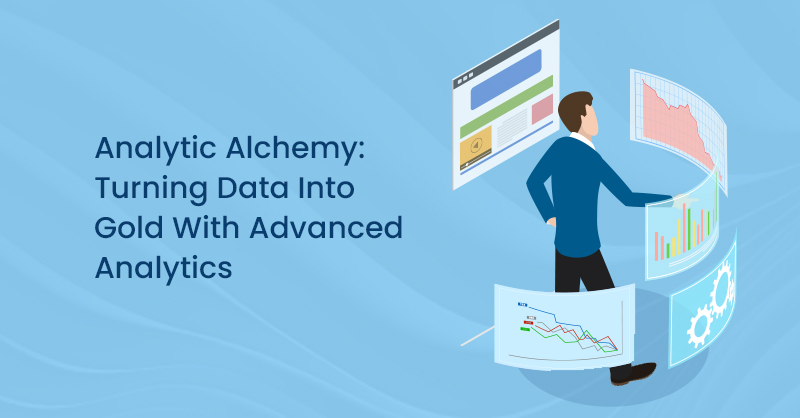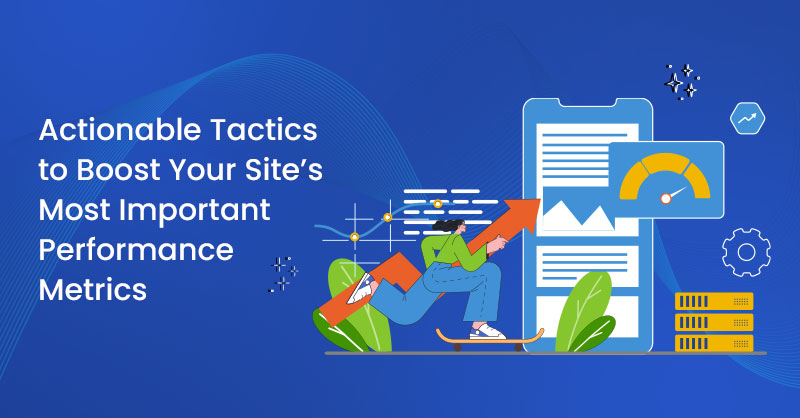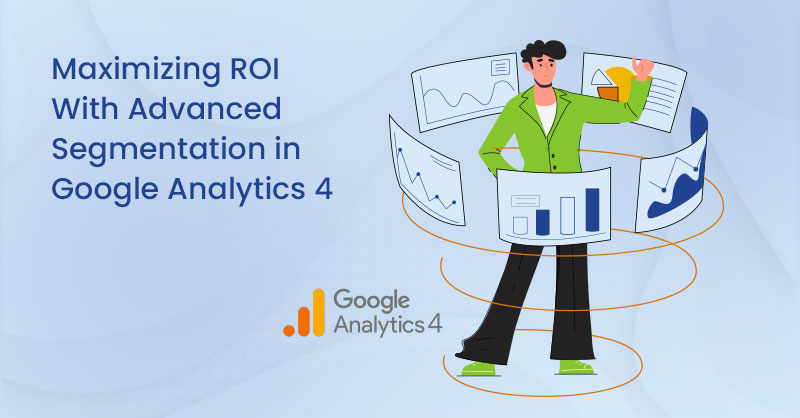Your website is not just a digital storefront; it's a bustling data goldmine. Every click, every scroll, every interaction is a potential nugget of information that holds the key to understanding your audience and driving your business forward.
However, here’s the kicker: most businesses are sitting on this treasure trove of data without realizing its full potential. It's like owning a gold mine and only ever digging a shallow pit.
By itself, raw data isn’t very useful. However, with the right tools and knowledge, you can convert this data into insights that will help you make informed decisions, refine your strategies, and, ultimately, boost your bottom line.
Below, we look at how advanced analytics practices can help you turn your website's raw data into a valuable resource that can drive your decisions.
The Power of Advanced Analytics
Your website generates lots of data, but in its raw form, this data doesn’t provide much value. For example, knowing that 10,000 people visited your website is raw data. There isn’t much you can do with this information.
However, knowing that 6,000 out of the 10,000 visitors viewed the same product is a business insight you can use to make informed business decisions. It tells you that this particular product is popular, so you might decide to optimize the sales page for that product.
So, how do you convert your raw website data into business insights? The answer is advanced analytics.
Advanced analytics refers to data analysis techniques that go beyond basic descriptive statistics and reporting. It involves the use of more sophisticated and complex tools and algorithms to extract valuable insights and predictions from data.
Whereas basic reporting gives you a snapshot of what already happened, advanced analytics is your crystal ball into the future. It doesn't just tell you that sales went up last quarter; it explains why they did and how to replicate that success. This helps you make informed decisions, allowing your brand to adapt and thrive in a rapidly changing business landscape.
Examples of Using Advanced Analytics
While advanced data analytics is often associated with tech industries and corporate business models, its applications are surprisingly diverse. Even professionals like contractors can benefit by diving into data for marketing purposes, as well as everyday tasks.
For instance, customer feedback metrics can shape future business decisions, while analyzing seasonal trends could inform when to stock up on materials or hire extra help. Likewise, advanced analytics can also provide more accurate insights on how to stock up on materials.
Likewise, a company can use advanced analytics to pinpoint the ideal time to launch a new product. Using data from the past, they can find out when customers interact with their brand the most, plus all kinds of other factors.

Source: Shutterstock
Advanced Analytics Practices You Can Use to Turn Data Into Gold
Here are some analytics practices that will help you harness the full potential of your data and empower you to make informed decisions.
User Behaviour Analysis
To extract value from data, you must first grasp the intricacies of how your audience interacts with your website. Understanding user behaviour is about deciphering the digital footprints left by your website visitors, which provide invaluable insights into their preferences, needs, and intentions.
User behaviour analysis isn't about interpreting a single click or an isolated page view; it's about painting a comprehensive picture of the user journey. It's understanding where visitors come from, what pages they visit, how long they stay, and where they drop off.
With this knowledge, you can quickly identify pain points in your user experience, anticipate their needs, and tailor your strategies to meet them.
That’s why, to navigate the world of user behaviour analysis effectively, you need to track metrics like bounce rate, conversion rate, session duration, and click-through rate. These metrics help you understand the effectiveness of your website and content marketing efforts.
Consequentially, combining them provides a holistic view of your users, enabling you to capitalize on your strengths and identify areas for improvement.
Traffic Acquisition Analysis
Traffic acquisition analysis is the process of examining and evaluating the sources and channels through which your website attracts visitors. It also looks at the keywords and external sites driving traffic to your site, as well as traffic variation over time.
This analysis helps you understand how visitors find and engage with your website and provides insights into the effectiveness of your marketing strategies. For instance, by identifying underperforming channels and refining your content and marketing strategies, you can ensure that you're attracting the right traffic—the kind that fuels your business's growth.
Ultimately, traffic acquisition analysis helps convert your traffic data into insights that can help you optimize your acquisition strategies, allocate resources effectively, and improve the overall performance of your website.
Customer Segmentation
Armed with the insights from your traffic acquisition analysis, you can now dive into customer segmentation with precision. Customer segmentation is all about dividing your customers into meaningful groups and delivering tailored experiences that cater to their unique needs and preferences.
Categorizing your visitors based on their sources of origin and behaviour on your site allows you to personalize your marketing efforts, content, and strategies. It's no longer a one-size-fits-all approach; it's about connecting with individuals on a personal level, providing them with what they seek, and guiding them along the path to conversion.
With customer segmentation, you are able to deliver the right message to the right people at the right time, optimizing your marketing spend and increasing your ROI. Ultimately, it helps you enhance your user experience and bolster your bottom line, ensuring that each interaction with your audience is a step closer to business growth and success.
Customer Journey Mapping
Customer journey mapping is a strategic analysis tool that helps you visualize and understand your customers’ experiences throughout their interaction with your website.
It involves creating a detailed representation of the customer's path from the initial awareness stage through the various touchpoints and interactions until post-purchase or ongoing engagement.
Therefore, a customer journey map is an excellent tool for analyzing user behaviour at different stages. By evaluating how users move through the journey, what actions they take, and where they abandon your site, you can identify pain points and opportunities for improvement.
Once you gain enough insights from the customer journey map, you can refine your content, marketing strategies, and user experience, ensuring that each stage of the customer journey aligns seamlessly with your business objectives.
Predictive Analytics
Data is of little use if you can’t use it to shape future decisions and strategies. Luckily, that’s where predictive analytics comes in.
Predictive analytics uses data, statistical algorithms, and machine learning techniques to identify patterns, make predictions, and inform decision-making. With predictive analytics, you can anticipate future outcomes or trends based on historical data and user behaviour.
By examining historical site data, you can build models to predict which content users are more likely to engage with, products they might purchase, or when they are likely to visit the site.
This predictive insight allows you to proactively tailor your strategies, content, and marketing efforts to meet user expectations.
In the end, advanced analytics turns data into a roadmap for your business. It equips you to proactively adapt to changing conditions and optimize your strategies for maximum impact. Think of it as a reliable predictive model, a guideline of sorts.

Source: Shutterstock
Time Series Analysis
Time series analysis is a statistical technique used to analyze site data collected over time, where each data point is associated with a specific timestamp. In other words, it is an examination of how metrics and trends like website traffic, user engagement, conversion rates, or sales change over time.
With time series analysis, you can uncover recurring patterns, seasonal trends, and other factors that influence user behaviour and the success of your marketing campaigns. In addition, you can recognize the moments of peak engagement, understand the ebb and flow of traffic, and predict future trends based on historical data.
Armed with these insights, you can allocate resources effectively, adjust your marketing strategies to coincide with peak periods, and make informed decisions that lead to business growth.
Funnel Analysis
Funnel analysis is another data-driven methodology used in web analytics to track and understand user behaviour on a website or application. Its primary goal is to identify and optimize the conversion process by identifying where users drop off or abandon their journey.
By setting up funnels, you can pinpoint the specific points in the user journey where drop-offs occur, allowing you to make data-driven decisions to optimize the user experience and increase conversions. This may involve optimizing landing pages, simplifying the checkout process, or addressing other issues hindering the user's progress.
The insights gleaned from funnel analysis can help you identify bottlenecks and tailor your marketing and user experience strategies based on data-backed evidence. By visualizing the user journey this way, you can improve your website's performance, boost user engagement, create a smoother path to conversion, and drive more revenue.
Backlink Analysis
Once you’ve refined your funnel, it’s also important to consider how external factors like backlinks can come into play. High-quality backlinks from reputable sources can funnel qualified leads into your sales pipeline. If you notice certain stages in the funnel experiencing drop-offs, investigate the role of your backlinks. Could they be directing the wrong type of traffic, or could the messaging be inconsistent with the landing page? Accurate analytics can help you assess this.
Natural Language Processing (NLP)
NLP is a branch of artificial intelligence that focuses on the understanding, interpretation, and generation of human language by machines. When applied to raw website data, NLP can be a powerful tool for deriving meaningful business insights from unstructured text, such as customer reviews, feedback, comments, and other textual content.
Furthermore, NLP allows you to go beyond quantitative data and understand the qualitative aspects of user interactions with your website. For instance, by analyzing user-generated text, you can extract valuable information, such as common customer pain points, popular features, and the emotional tone of user reviews.
This deeper understanding of your customers enables you to tailor your products, services, and marketing strategies to meet their specific needs and concerns.
Reporting and Visualization
Reporting and visualization involves presenting raw website data in a clear and visually engaging format, such as charts, graphs, tables, and reports, to make complex data more understandable and actionable.
This approach is instrumental in transforming raw website data into business insights, as it helps stakeholders easily interpret and extract valuable information in a single file or data dashboard. Instead of sifting through raw data tables, decision-makers can quickly grasp trends, patterns, and anomalies when data is presented visually. This aids in identifying KPIs and understanding how different metrics interact.
Exporting and sharing your insights is another crucial part of any analytics process. While data dashboards are invaluable, sometimes a static, portable format like a PDF is more suitable for sharing insights with stakeholders.
So when dealing with large amounts of data, using reliable PDF editing software can help you tailor your reports, adding or removing elements to effectively convey the most relevant information. This is especially beneficial when you need to compile data from multiple sources into a single, easily digestible report. After all, reports must be readable and user-friendly.
Machine Learning
Machine learning involves the use of special algorithms designed to identify patterns, make predictions, and uncover hidden relationships within vast and complex datasets, such as your website data.
One of the benefits of machine learning is that it automates the process of analyzing your site data, making it more efficient and scalable. Instead of manually sifting through mountains of data, machine learning models can rapidly process and extract relevant information.
Additionally, machine learning models can uncover insights that might not be immediately apparent to human analysts. These range from understanding user behavior and preferences to predicting future trends or identifying anomalies, such as fraudulent activity or unusual patterns in user engagement.

Source: Shutterstock
Wrapping Up
Every interaction users have with your website generates some data, but this data by itself isn’t valuable. To make the most of this data, you need to find a way to make sense of it and use it to drive informed decision-making.
The advanced analytics processes we’ve covered here act as a philosopher’s stone, turning raw data into golden insights that can help you optimize strategies effectively and drive bottom-line results.
Do you want to invest in digital marketing and need help getting started? Say no more! At TechWyse Internet Marketing, we specialize in SEO, Paid Media, Web Design and everything in between. Work with our expert team and watch your business rise above your competitors! To schedule an appointment, call (416) 410-7090 or contact us here.






